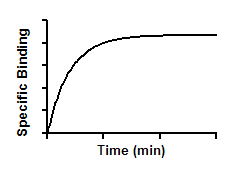Introduction
When you measure the association rate of a radioligand, the rate at which the binding equilibrates depends not only on the association rate constant and the amount of ligand you used, but also on its dissociation rate constant. (Why?) The only way to fit the association rate constant by analyzing association data from one concentration of radioligand, is to constrain the dissociation rate constant to a value you determined in a different experiment.
Alternative methods of determining an association rate constant are to globally fit data obtained with multiple radioligand concentrations, or to analyze an experiment that measuresboth association and dissociation rate sequentially.
Step by step
Create an XY data table. Enter time in minutes into X, and specific binding into Y.
From the table of specific binding, click Analyze, choose nonlinear regression, choose the panel of Kinetics Binding equations, and choose Association kinetics - One conc. of hot.
You must constrain Hotnm ([radioligand] in nM) and Koff (dissociation rate constant, in inverse minutes) to constant values.
Model
Kd=Koff/Kon
L=Hotnm*1e-9
Kob=Kon*L+Koff
Occupancy=L/(L+Kd)
Ymax=Occupancy*Bmax
Y=Ymax*(1 - exp(-1*kob*X))

Interpret the parameters
Kon is the association rate constant, in units of M-1 min-1
Kd is the equilibrium dissociation constant, in Molar, computed as Koff/Kon
Bmax is the maximal binding at equilibrium, extrapolated to maximal radioligand concentration, in the units used to enter the Y values.